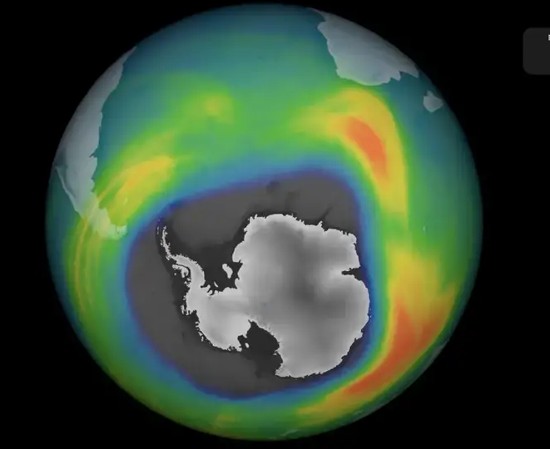Back in the 1980s, the use of hydrofluorocarbons in refrigerators, air conditioners, fire extinguishers, and aerosol cans was seen as contributing to a pending environmental catastrophe. The gas escaping from manufacturers and discarded equipment was making its way into the stratosphere and damaging ozone.
Ozone can be found in the lower and upper atmosphere. In the former, it poses a danger to health. In the latter, it provides a protective barrier to block harmful ultraviolet (UV) rays from the Sun reaching the surface.
In the lower atmosphere, ozone’s presence produces smog. Where does this ozone come from? We are the source producing the chemicals in paints and other products and from oil refineries. The internal combustion engines that we use to power our cars emit ozone from vehicle tailpipes. If you have ever walked down a busy street where there is a lot of traffic, if your eyes start to smart, you are feeling the effects of ozone.
When ozone is depleted from the upper atmosphere in the layer called the stratosphere, we lose its protective properties that act as a barrier to ultraviolet (UV) rays emitted by the Sun. Excess exposure to UV rays with a depleted layer of ozone is associated with increased skin cancer and cataracts. It also is known to weaken the immune system, reduce crop yields and negatively impact marine life.
Attacking the Two Ozone Problems
During the 1980s, the alarm went off regarding ozone depletion in the upper atmosphere. Holes in the ozone layer were opening over the Earth’s poles. Ozone depletion was increasing their size, posing a growing threat to the health of humans and other species. The nations of the world bought the science and came to a global agreement called the Montreal Protocol, signed in 1987. The phase-out of ozone-depleting hydrofluorocarbons began.
At the same time, medical research showed that ground-level ozone was contributing to ill health. In children, it was causing asthma. In adults, it was damaging lungs leading to emphysema, bronchitis, pneumonia and permanent scarring of the tissue.
A solution existed. It was called the catalytic converter, invented early in the 20th century but first patented in 1952. A catalytic converter could screen out noxious gasses like nitrous oxides and ozone from combusted gasoline and diesel fuels used by internal combustion engines. The adoption of the catalytic converter by the automotive industry took off in the late 1960s when governments began to enact stringent emission control regulations. Today, all cars and trucks are equipped with catalytic converters.
So you would think that regulation and invention would have saved us from ozone. Well, it has not because recent measurements by the European Space Agency’s Copernicus Sentinel-5P satellite indicate an ozone hole has opened up over Antarctica covering 26 million square kilometres (10 million square miles). Are we responsible for this hole, or is the cause natural?
The 2022 eruption of the volcano Hunga Tonga-Hunga Ha‘apai (seen below in images captured by a NASA satellite) may be the biggest contributor to this latest depletion of ozone in the stratosphere. The eruption spread dust, ash, water vapour and chlorofluorocarbons into the stratosphere. It caused a polar vortex of high-speed winds to surround Antarctica leading to ozone depletion.

Policing the Ozone Layer
The emergence of ozone-detecting Earth-orbiting satellites has given us new insights into understanding the nature of the ozone layer and its fluctuations. In the Antarctic, the ozone hole increases from August to October reaching a maximum through mid-September to October when temperatures start to rise in the southern hemisphere. Ozone depletion reverses with the hole shrinking by the start of summer.
Did the Arctic experience a similar enlargement of its ozone hole? Apparently not, which lends credence to the volcanic origins of this recent change over Antarctica.
But human-engineered ozone remains a problem coming largely from petrochemical industrial sources. Where is it worse? The Persian Gulf has the highest concentrations of industrial ozone. Qatar leads the way. Another country with high ozone levels is Nepal where rapid urbanization and industrial pollution in the Kathmandu Valley are seen to be the cause. High levels of ozone pollution can be found in India, Bangladesh, Bahrain, Pakistan, Kuwait, Iraq, South Korea, and Saudi Arabia, while the lowest levels are in Pacific island nations and Papua New Guinea.
And satellites continue to detect hydrofluorocarbons being emitted from industrial sources. The offenders include industries in the United States, Great Britain, the European Union, Russia, South Africa, China, South Korea and Japan.
Before the latest enlarged hole opened over Antarctica, scientists were optimistic that the ozone layer would be restored to conditions in 1980 by 2040. But now some forecasts are far darker indicating that with the continued production of hydrofluorocarbons, not including natural events that could speed up ozone layer depletion, we could see it disappear over Antarctica by 2066, and over the Arctic by 2045.
We thought we had it licked, but apparently not.









